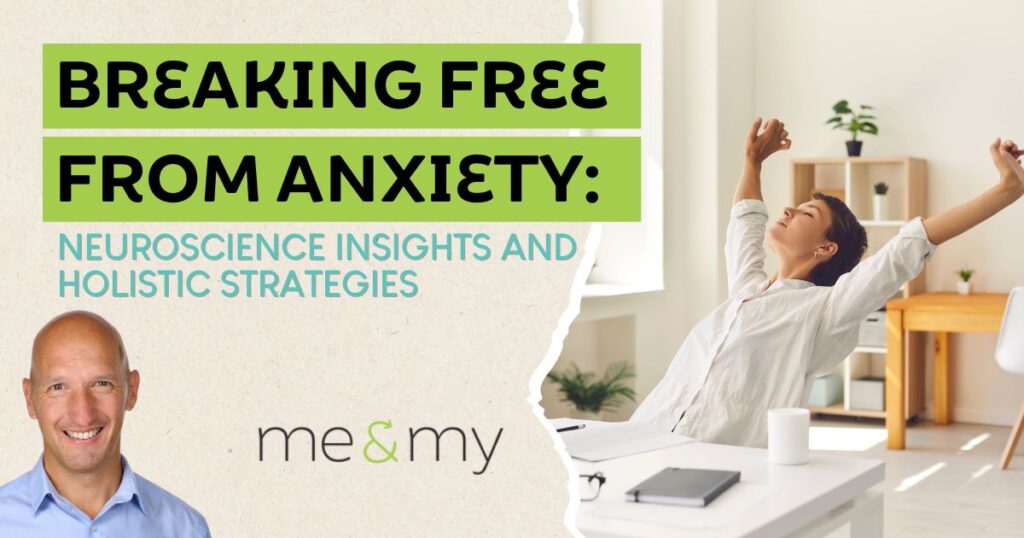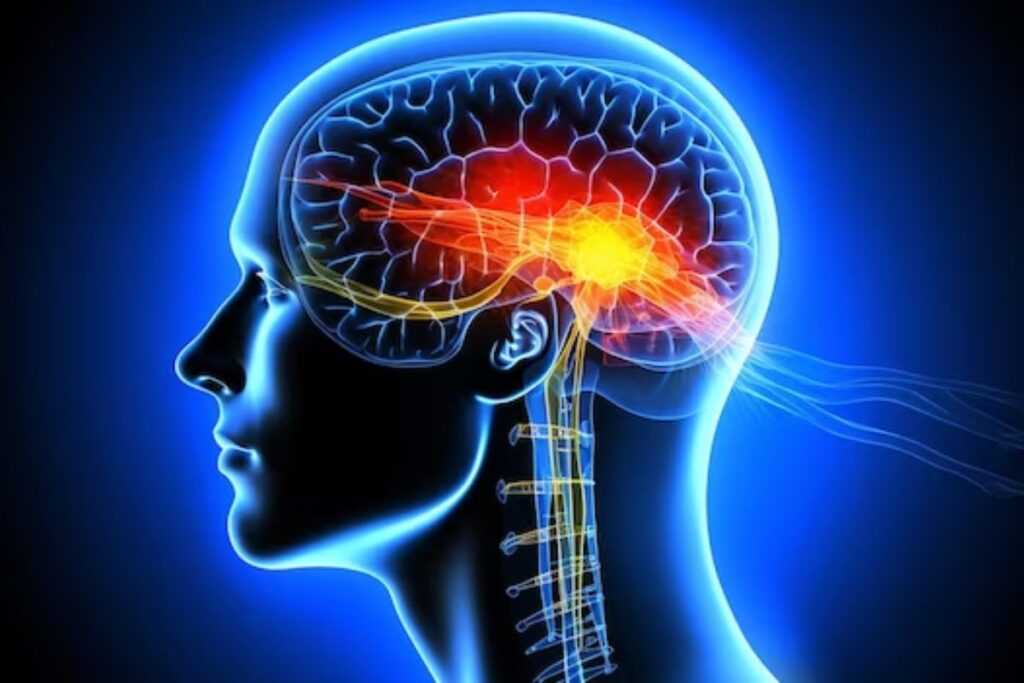Breaking Free from Anxiety: Neuroscience Insights and Holistic Strategies

In today’s fast-paced world, anxiety has become an unwelcome companion for many of us. The weight of looming deadlines, societal expectations, and personal challenges can often feel suffocating.
But what if we told you that the key to unlocking the chains of anxiety lies deep within our brain? Inspired by the insights from the me&my health up podcast episode, where host Anthony Hartcher delves into the neuroscience of breaking free from anxiety, we embark on a journey to understand the intricate dance of neurons that orchestrate our feelings of unease.
By peeling back the layers of our brain’s complex architecture, we not only discover the root causes of anxiety but also arm ourselves with powerful strategies to reclaim our peace and equilibrium.
Watch the full episode here:
Breaking Free from Anxiety: Neuroscience Insights & Proven Strategies
Understanding Anxiety at its Core

Anxiety, while often perceived as a mere emotional response, is fundamentally anchored in the sophisticated workings of our brain. The conductor is the amygdala, a small almond-shaped structure nestled deep within our brain’s temporal lobe.
Often dubbed the brain’s “emotional control centre,” the amygdala is responsible for detecting and interpreting emotional stimuli.
The Role of the Amygdala
While the amygdala manages a range of emotions, it’s particularly attuned to those of fear and anxiety. Think of it as a vigilant sentinel, always on the lookout for potential threats.
When it detects something amiss, it swiftly evaluates the situation. If it deems the stimulus as threatening, it initiates a cascade of reactions to prepare the body for a potential ‘fight or flight’ response.
The Release of Stress Hormones

One of the amygdala’s immediate reactions to perceived threats is signalling the release of neurotransmitters epinephrine and norepinephrine and stress hormones, notably cortisol. These neurotransmitters and hormones act as messengers, alerting various parts of the body to prepare for imminent danger.
While this was crucial for our ancestors, who faced physical threats, in today’s world, this response can be triggered by everyday stresses, leading to prolonged periods of anxiety.
The Modern Implications
In contemporary society, where threats are more psychological than physical—think work pressures, social expectations, or financial worries—the amygdala’s response can sometimes be excessive.
This overactivity can lead to chronic anxiety, where individuals feel constantly on edge, even in the absence of a tangible threat.
The Brain’s Remarkable Ability to Adapt and Evolve

The human brain, once believed to be a rigid and unchangeable organ, has proven to be one of the most adaptable parts of our body, thanks to the phenomenon known as neuroplasticity. This concept has revolutionised our understanding of the brain’s capabilities and offers a promising avenue for those grappling with anxiety.
Defining Neuroplasticity
At its core, neuroplasticity refers to the brain’s inherent ability to reorganise itself by forming new neural connections. This adaptability ensures that our brain can adjust its activities in response to new situations, challenges, or even after injuries. It’s akin to a city’s road network, where if one route is blocked, an alternative can be found.
Implications for Anxiety Management

For individuals facing anxiety, the principle of neuroplasticity offers a glimmer of hope. It suggests that our brain’s current response to certain stimuli, which may lead to anxiety, isn’t set in stone.
With targeted interventions, such as cognitive behavioural therapy or mindfulness practices, we can effectively “retrain” our brain to react differently, diminishing the intensity of anxiety or even preventing its onset.
Harnessing the Power of Positive Experiences
Just as negative experiences can shape our brain’s response, positive ones can too. By consciously engaging in positive experiences and mindfulness practices, we can foster neural pathways that promote calmness and resilience. Over time, these pathways can become our brain’s default response, reducing the grip of anxiety.
The Role of Consistency
While the brain’s adaptability is a beacon of hope, it’s essential to understand that meaningful change requires consistent effort. Just as a muscle strengthens with regular exercise, the brain’s new pathways solidify with consistent positive experiences and practices.
Strategies to Break Free from Anxiety
1. Mindfulness and Meditation

- The Science Behind Mindfulness: Mindfulness is more than just a buzzword; it’s a scientifically-backed practice that involves anchoring our attention to the present moment. By doing so, we prevent our minds from ruminating on past regrets or future worries, common triggers for anxiety.
- Benefits for the Brain: Regular mindfulness practice has been shown to reduce the size and activity of the amygdala, the brain’s primary centre for processing fear and emotional responses. As the amygdala’s reactivity decreases, so does our propensity to experience anxiety.
- Starting the Practice: Even a few minutes of focused breathing, grounding exercises, or guided meditation daily can set the foundation for a more mindful approach to life, gradually equipping the brain to better handle stressors.
2. Cognitive Behavioural Therapy (CBT)

- Understanding CBT: Cognitive Behavioural Therapy is a structured, goal-oriented therapy that focuses on identifying and rectifying negative thought patterns and behaviours that contribute to anxiety.
- The Process: Through CBT, individuals learn to recognise triggers and the thought patterns that spiral into anxiety. They’re then equipped with tools to challenge these thoughts, replace them with more balanced perspectives, and adopt behaviours that reduce anxiety.
- Evidence-Based Results: Numerous studies have highlighted CBT’s effectiveness, with many individuals experiencing a significant reduction in anxiety symptoms, often making it a preferred choice for therapists and psychologists.
3. Physical Activity

- Beyond Just Fitness: While most associate physical activity with physical health, its benefits for mental well-being are profound. Engaging in regular exercise acts as a natural antidote to anxiety.
- Endorphin Release: Physical activity stimulates the release of endorphins, neurotransmitters that act as the body’s natural painkillers and mood elevators. This endorphin boost can counteract feelings of anxiety and promote a sense of well-being.
- Choosing the Right Activity: It doesn’t require intense workouts to reap these benefits. Activities like walking, yoga, or even dancing can be effective. The key is consistency and finding an activity that one enjoys, ensuring it becomes a sustainable habit.
Nutrition’s Influence on Anxiety Management
Omega-3 Fatty Acids

- Brain-Boosting Benefits: Omega-3 fatty acids, particularly eicosapentaenoic acid (EPA) and docosahexaenoic acid (DHA), play a crucial role in brain function. They form an integral part of cell membranes in the brain and influence the function of cell receptors in these membranes.
- Research Insights: Several studies have linked a higher intake of omega-3s to decreased levels of anxiety. For instance, individuals with a regular intake of fish, a primary source of omega-3s, often report better mood stability and reduced anxiety symptoms.
- Dietary Sources: While fatty fish like salmon, mackerel, and sardines are the most renowned sources, omega-3s can also be found in chia seeds, flaxseeds, and walnuts, catering to those who prefer plant-based sources.
Magnesium

- The Relaxation Mineral: Often termed the ‘relaxation mineral’, magnesium plays a pivotal role in over 300 enzymatic reactions within the body, including those that regulate the stress response.
- Anxiety and Magnesium: A deficiency in magnesium can lead to heightened stress and anxiety levels. On the flip side, ensuring adequate magnesium intake can act as a protective barrier against the onset of anxiety.
- Incorporating Magnesium-Rich Foods: Spinach, almonds, and black beans are excellent sources of magnesium. Incorporating these into daily meals can ensure a steady intake of this essential mineral, promoting better mental well-being.
The Power of Connection
The Innate Need for Social Bonds

- Evolutionary Perspective: From an evolutionary standpoint, humans have always thrived in groups. Our ancestors relied on collective strength for survival, be it hunting, gathering, or protection. This inherent need for social connection has been hardwired into our DNA.
- Modern Implications: In today’s digital age, while the nature of threats has evolved, the essence remains unchanged. The support and understanding derived from social bonds offer a sanctuary from the stresses of modern life.
The Therapeutic Effect of Sharing

- Vocalising Emotions: Articulating our feelings, especially anxieties, can be cathartic. It allows us to process emotions, gain clarity, and often view our concerns from a fresh perspective.
- The Listening Ear: Sometimes, it’s not about finding solutions but having someone listen without judgement. An empathetic ear can provide validation, making one feel seen and understood.
Building Resilience Through Relationships

- Support Systems: Having a reliable support system, be it family, friends, or support groups, can significantly mitigate the effects of stress and anxiety. Knowing there’s someone to lean on can instil a sense of security and belonging.
- Collective Coping: Engaging in group activities, attending support group meetings, or simply spending time with loved ones can introduce us to diverse coping mechanisms. Observing and learning from how others handle stress can offer new strategies to manage our own anxieties.
Conclusion
Breaking free from anxiety is not about eliminating it entirely but learning to manage it effectively. With the insights from neuroscience and the strategies mentioned above, we can pave the way to a life where anxiety doesn’t hold the reins.
Remember, seeking professional help is always a commendable step in your journey to break free from anxiety.
Your Path to Holistic Healing with me&my wellness
Understanding the neuroscience behind anxiety is just the beginning. At me&my wellness, we offer holistic health coaching tailored to your unique health and wellness goals.
Dive deeper into personalised strategies to break free from anxiety and achieve a balanced life. Ready to embark on a transformative journey? Book a consultation with us and harness the power of holistic healing.

